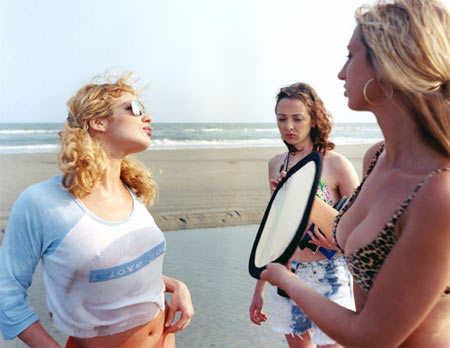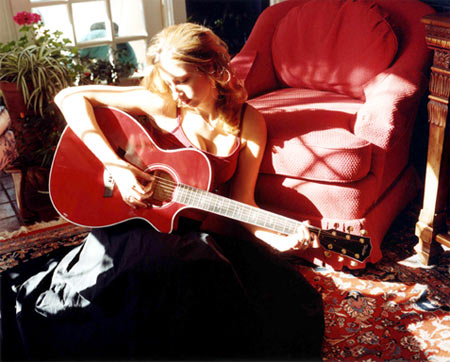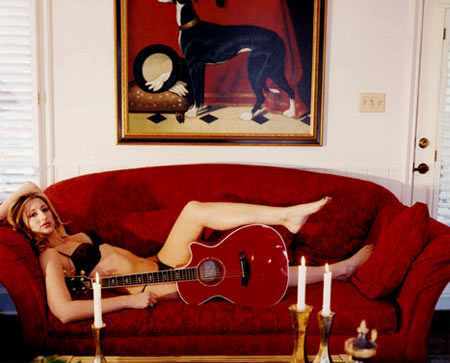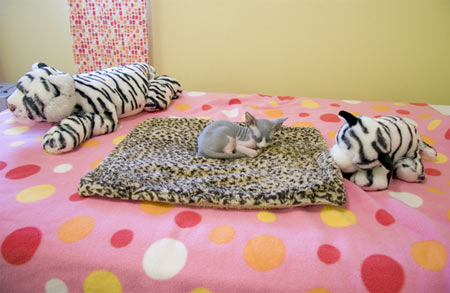A Conversation With Sarah Martin

When I looked at Sarah Martin’s photography and at her statements, which provide the background, a whole set of questions popped up in my head, and I asked Sarah whether she was willing to talk about her work. I was thrilled to learn that she was.

Jörg Colberg: An interview is usually about finding out about what someone else is thinking about, but I’ll have to make a little bit of an exception here - at least just to start this of. Often, when I see work that has very personal connections for the photographer, I am not all that much touched, because - maybe apart from the fact that I grew up in the northern bits of Germany, where people are a bit more reserved - creating something that has personal meaning, but that also reaches out to whatever is outside of that personal meaning appears to be quite hard. For me, your case was is different, because even though I literally have no connection with your background - the conservative and religious American South - I felt that your photography has a lot to say about our general human condition. I am wondering how you approached the “Virgin Series”. What kind of planning did go into this? How did you manage to stay clear of making just ironic photos - which, I guess, might be tempting?
Sarah Martin: My dad always told me that everyone was basically the same, “we all fear rejection, we all want to be accepted by those we love.”
I started making the “Virgin Series” between my first and second year of graduate school. I was encouraged by Dave Hickey to continue working on the series after he had seen a video I made of the girls and myself the year before at the beach working on a “Virgin Calendar”. Of course, before I moved away from Tennessee to begin grad school, I really didn’t think that much of our leisure activities.
When I moved to Connecticut and stepped outside of my social circle, I naturally began to question what I believed and what I had been taught. When I would go back home I felt really disconnected from my family and old friends. I didn’t want to feel that way, I still wanted their acceptance and their time.
I rarely plan my photo projects. My formula for a good day = bikini + camera + hairspray.
Seriously though, I could only make these photos because I knew and understood their desires so well. In a way the making of these photographs assured me that what they wanted was OK (looking hot) and what I wanted (to still be accepted) was OK.
JC: So staying clear of having too much irony seep into the project was never a big problem? I guess, to some extent, it might depend on how much distance being away from where you grew up had already created?
SM:I wasn’t considering ironic juxtapositions while I was photographing, I was involved with the project as an experiment of sorts. I had too many questions about myself and my relationship to these women to have an idea of how a viewer might respond to the images.


JC: And then, of course, I am curious about how your models - who are models for their own photo series and your old friends - reacted to your work, to you taking photos of them. How did you explain to them what your interest was?
SM: That’s a good question. What I love the most about photography is the act of collaboration in portraiture. The people I photograph always have better ideas for picture making than I do. When I was making the portrait diptychs “For My Parents, For My Boyfriend”, I asked each girl to pick what she would wear for each portrait, where she wanted the photograph taken, how she would pose, etc. I was clear that one portrait could be used to represent both the parent and
boyfriend portrait, however, each girl photographed, chose two separate images. It became interesting for me to see how each girl wanted to present themselves to please each anticipated audience.
Most of the girls liked the work (I did have to promise not to show the “racy” ones to some of their mothers), I don’t think many of my friends care that much about galleries, artist statements or my projects, which is more than fine with me.
JC: I have a bit of a hard time understanding this. The first thing is that while some commercial photographers, who are under constant pressure to come up with “cool” portraits (some form of irony - ideally easily understandable for everybody - is often an ingredient), have had to try quite hard to produce this kind of imagery, you basically got it for free, with your models being completely serious about this. But then underneath all of this, there’s this huge contradiction, created by the fact that on the one hand sex is supposed not to happen before marriage (and I don’t even want to go into Clintonesque discussions about what is meant by “sex”…), and on the other hand, in this very same society, young - and to an increasing extent older - women have to look sexy or “hot”, as you called it. I guess having those “sexy” photo shoots is some sort of outlet, but then, it also creates exactly the kind of imagery that makes this contradiction for the women even more apparent. What am I missing here?
SM: Hmmmmmm… it seems like many times when I consider irony in contemporary art, I think of there being some sort of hierarchy between artist and subject, irony distancing rather than redefining or reshaping the subject. Very often forced irony, inflated or mocking imagery, lacks empathy. This IS my world. I am not detached from it- thereby looking at it like a stranger or outsider. This isn’t about foreshadowing “style”. We, they, were retrieving the myth of ‘hotness’ or ‘sexiness’, retrieving what it means with REAL longing and REAL desire and REAL innocence mixed in.
I think of that Silver Jews song that talks about Tennessee being the “land of hot middle age women”. It’s kind of true, there is a lot of pressure at home that if you aren’t supportive of your husband’s career, perky, want to birth at least 3 kids, a Sunday school teacher and a size 4, your husband has reason to move on (not really, but still, a sincere fear).
I admit that I was always confused (still am) about how I was expected to remain pure until marriage and then all of a sudden become a hot sex kitten for my husband. I don’t think I had any friends whose parents were divorced growing up, so I assumed that the Biblical approach to marriage was the way to go.
But what happens when your hormones kick in? What does one do in that 10-15 year span of dating without sex? That is a loooooooong time to dry hump (which is frowned upon). Several of my friends answered that question by marrying by the age of twenty.
Our club did function as an accountability group where after imagining and acting out PG-13 sexual fantasies, we would swear over martinis at night (also frowned upon) that we were all going to stay virgins until our honeymoon. I do think we used this time as a way to try and understand our role as women ready to get married. We all made it through college because of this group. No one wanted to be the quitter-slut.

JC: “You Are What You Love” deals with another aspect of your upbringing, and with - if I’m not mistaken - trying to figure out what to make of this conflict between what you were taught then and later. How did this project help you to find an answer to the question of whether you were “missing the point”, when not sticking to the idea that you balance your life, if you sort your priorities as “Jesus, Others…and then, You”? Did you find that answer?
SM: I am always open to the fact that I could be wrong (or at least slightly off) about my ideas or beliefs. I always tell my parents that I would love to have faith, it would make my life so much easier and I could spend more money on electronics and less on therapists and prescription drugs. I would fit in at family holiday parties, class reunions, chick-fil-a…the list goes on and on.
I ordered this self-help book on Amazon before I started taking pictures this summer, it was called “You Are What You Love” (very hippy dippy, but it was entertaining) and the author, at the end of most chapters wrote “you are what you love and you love what you are giving your attention to”. I also was listening to Jenny Lewis’ new album and couldn’t stop playing “You Are What You Love” and singing the chorus “You are what you love and not what loves you back”. So when I went home, I just started photographing what/who I love and/or what they love (I just want to be clear that hairless cat is not mine, it’s my sisters).
The more I thought about what I loved, I became more comfortable balancing my priorities with just an O.Y.

JC: And how did you explain this to your subjects? For them, it might (or maybe even must) have been a bit of the opposite experience to see you coming back and working on this kind of subject matter - or maybe not?
SM: It was strange, most of these images were taken at my old southern Baptist church, where I haven’t been in 10 years. I had to go ask permission to make photographs from my old pastor who had baptized me during my teens and presented me with all my bible drill trophies.
I was nervous to talk with him at first, but we ended up having a really good conversation about predestination and when I told him that I used photography to help me sort through my priorities, he then asked if I was working out my salvation with a camera. I thought that was perfect.
 By
By